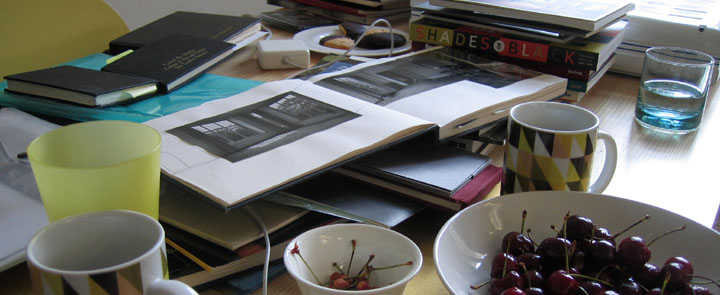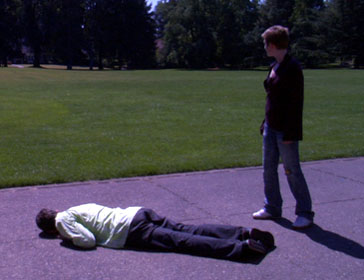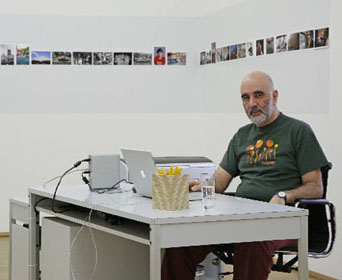
LUCIEN SAMAHA, NEW YORK, NY
6:30 P.M. BACK ROOM SUPPER SYMPOSIUM
7:30 P.M. VOLLUM LOUNGE, REED COLLEGE CAMPUS
PUBLIC LECTURE BY EXHIBITING ARTISTS
BACK ROOM supper symposium with exhibiting artists
Hadley+Maxwell and writer Lisa Robertson, hosted by Matthew
Stadler. This special evening happens on the occasion of the
Cooley Gallery exhibition. For tickets, and more information
go to: http://www.thebackroompdx.com/
Join us for a public lecture by exhibiting artists Lucien Samaha
and Hadley+Maxwell. The talk is followed by a reception at the Cooley Gallery.The Cooley Gallery will be open from 12 p.m. – 9 p.m. on Monday, November 6.


"We 'feel free' precisely because we lack the very language to articulate our unfreedom." — Slavoj Zizek
Hadley+Maxwell consider subjectivity and political experience through moving image, song, drawing, and printed matter, working, in part, from photographs of the Kent State riots on May 4, 1970, as chronicled in news magazines of the time. During the summer of 2006, Hadley+ Maxwell improvised these photographs on the Reed College campus, alternating roles as victim and bystander, corpse and "person," re-imagining and re-opening consideration of the images as historical records, but more critically, as spaces for the incomplete and idiosyncratic articulation of gesture, time, and attachment.
While the video is projected onto small, cut-out representations of the artists and reflected around the room, the artists ground our experience on the textured surfaces of a series of delicate graphite drawings based on the Kent State photographs. The drawings carefully record a process of identification between the artists and their subject, taking on the quality of a body of evidence that exists somewhere between public and private experience. Permeating the space is a recording of Hadley singing a somber and matter-of-fact rendition of "Gloomy Sunday," a song written by Rezsô Seress in 1933 that was banned from the airwaves in the 1940s for being too damn sad.
Throughout the installation, the bodies of the artists are cropped and rescaled, deleted and reinserted. This dislocation makes space for,
and summons, the viewer into the work — an invitation to "be-together" that resists over-definition; an invitation to "be" together,
in consideration of something meaningful, an invitation to "be-together-in-meaning." What Hadley+Maxwell invite the viewer to engage in, they first and foremost do themselves, together. The installation is neither a practice run for something else, nor a partial action.
Accompanying Hadley+Maxwell's installation is Promise, a 22-ft. flag pole waving a white flag at half staff that will be installed on the great lawn across from Eliot Hall, Reed's oldest building. Promise comes to Reed from Vancouver BC, where it was first installed in front of the Contemporary Art Gallery of Vancouver as part of the exhibition Deleted Scenes (March 31–May 28, 2006, curated by Jenifer Papararo).
Hadley+Maxwell (Hadley Howes and Maxwell Stephens) began working and living together in 1997 in Vancouver, Canada. They have exhibited and published work across Canada and internationally, recently at the Vancouver Art Gallery and the Contemporary Art Gallery, Vancouver, the Saidye Bronfman Centre for the Arts, Montréal, and the Western Bridge, Seattle. Hadley+Maxwell’s practice includes silk-screen, photography, video, sculpture and site-responsive work, and often involves extending their collaboration to include third persons, investigating mediation as the condition of being-together.
Lucien Samaha photographs situationally — continually documenting life as it unfolds around him while pursuing formal, social, and personal compulsions — such as photographing people touching cheek to cheek, or playfully exploring the work of friends such as the Austrian artist collective Gelitin. Samaha is driven by how people relate to each other photographically, exploring the significance and value of the photographic object, specifically in relation to the global art market, new image technologies, and the elusive, sometimes deceptive nature of the on-line environment. To describe Samaha as an obsessive photographer of the everyday is something of an understatement. Since the 1970s Samaha has created an archive of over 300,000 images that he has purposed in exhibitions and site-specific projects around the world.
For "I want to show you somewhere." Samaha comes to work at the Cooley Gallery for the duration of the exhibition. It is a project that Samaha doesn't like to say too much about, as it involves rich surprises for those who venture to engage him in the space. Suffice it to say that Samaha has assembled 100 photographs from his archive and he wants to talk with you about them. He wants to get to know you. Samaha plans to continue the project around the world, as it involves meeting as many people as possible, both in and out of art institutions, and investigating the various roles that we all play in producing and determining the value of images.
Samaha's project continues from the Museum für Moderne Kunst, Frankfurt, Germany, where it began in the exhibition "Gut ist was gefallt." - "Good is What Pleases." from Jan 15—Feb 12, 2006, a group exhibition with Hans-Peter Feldmann and Wolfgang Tillmans.
Lucien Samaha has been photographing his life and adventures since he took one of the first photography courses offered in a US High School in 1973. Photography has been Samaha's companion throughout his many careers, including that of a TWA Flight Attendant; a Marketing Manager for Eastman Kodak Company where he was instrumental in the launch of the first digital camera; and a world renowned DJ on the 107th floor of the World Trade Center. Samaha has exhibited his work at spaces including: the Museum für Moderne Kunst, Frankfurt, Germany; the Center for Opinions in Music and Art (C.O.M.A.), Berlin; the Elizabeth Foundation, NY; the Sara Tecchia Roma Gallery, NY, NY, and the Feldman Gallery, Pacific Northwest College of Art, Portland, OR. Samaha was a finalist for the Nam June Paik award in 2004.